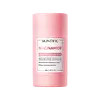What's inside
What's inside
 Key Ingredients
Key Ingredients

 Benefits
Benefits

 Concerns
Concerns

No concerns
 Ingredients Side-by-side
Ingredients Side-by-side

Water
Skin ConditioningPolyvinyl Alcohol
Glycerin
HumectantAgave Americana Stem Extract
Skin ConditioningSodium Hyaluronate
Humectant1,2-Hexanediol
Skin ConditioningCaprylyl Glycol
EmollientPolyglyceryl-10 Laurate
Skin ConditioningChlorella Vulgaris Extract
Skin ConditioningGlucose
HumectantButylene Glycol
HumectantEthylhexylglycerin
Skin ConditioningFructooligosaccharides
HumectantFructose
HumectantXanthan Gum
EmulsifyingCynanchum Atratum Extract
Skin ConditioningCaprylic/Capric Triglyceride
MaskingHydrogenated Lecithin
EmulsifyingAlthaea Rosea Flower Extract
Skin ConditioningCeramide NP
Skin ConditioningTocopherol
AntioxidantPancratium Maritimum Extract
BleachingCollagen Extract
Skin ConditioningSodium Stearoyl Glutamate
CleansingWater, Polyvinyl Alcohol, Glycerin, Agave Americana Stem Extract, Sodium Hyaluronate, 1,2-Hexanediol, Caprylyl Glycol, Polyglyceryl-10 Laurate, Chlorella Vulgaris Extract, Glucose, Butylene Glycol, Ethylhexylglycerin, Fructooligosaccharides, Fructose, Xanthan Gum, Cynanchum Atratum Extract, Caprylic/Capric Triglyceride, Hydrogenated Lecithin, Althaea Rosea Flower Extract, Ceramide NP, Tocopherol, Pancratium Maritimum Extract, Collagen Extract, Sodium Stearoyl Glutamate
Water
Skin ConditioningGlycerin
HumectantButylene Glycol
HumectantTitanium Dioxide
Cosmetic ColorantVolcanic Soil
Skin ConditioningMica
Cosmetic ColorantKaolin
AbrasiveNiacinamide
SmoothingDiglycerin
HumectantArbutin
AntioxidantSodium Palmitate
CleansingBeta-Glucan
Skin ConditioningPanthenol
Skin ConditioningMineral Salts
Skin ConditioningTranexamic Acid
AstringentSodium Hyaluronate
HumectantRhamnose
HumectantJojoba Wax PEG-120 Esters
PEG-40 Hydrogenated Castor Oil
EmulsifyingCI 77491
Cosmetic ColorantCI 77492
Cosmetic ColorantMenthyl Lactate
MaskingCI 45380
Cosmetic ColorantGlycyrrhiza Glabra Root Extract
BleachingPunica Granatum Fruit Extract
AntioxidantHydroxypinacolone Retinoate
Skin ConditioningPhenoxyethanol
PreservativeCaprylyl Glycol
EmollientAroma
Ethylhexylglycerin
Skin ConditioningDimethyl Isosorbide
SolventWater, Glycerin, Butylene Glycol, Titanium Dioxide, Volcanic Soil, Mica, Kaolin, Niacinamide, Diglycerin, Arbutin, Sodium Palmitate, Beta-Glucan, Panthenol, Mineral Salts, Tranexamic Acid, Sodium Hyaluronate, Rhamnose, Jojoba Wax PEG-120 Esters, PEG-40 Hydrogenated Castor Oil, CI 77491, CI 77492, Menthyl Lactate, CI 45380, Glycyrrhiza Glabra Root Extract, Punica Granatum Fruit Extract, Hydroxypinacolone Retinoate, Phenoxyethanol, Caprylyl Glycol, Aroma, Ethylhexylglycerin, Dimethyl Isosorbide
 Reviews
Reviews

Ingredients Explained
These ingredients are found in both products.
Ingredients higher up in an ingredient list are typically present in a larger amount.
Butylene Glycol (or BG) is used within cosmetic products for a few different reasons:
Overall, Butylene Glycol is a safe and well-rounded ingredient that works well with other ingredients.
Though this ingredient works well with most skin types, some people with sensitive skin may experience a reaction such as allergic rashes, closed comedones, or itchiness.
Learn more about Butylene GlycolCaprylyl Glycol is a humectant and emollient, meaning it attracts and preserves moisture.
It is a common ingredient in many products, especially those designed to hydrate skin. The primary benefits are retaining moisture, skin softening, and promoting a healthy skin barrier.
Though Caprylyl Glycol is an alcohol derived from fatty acids, it is not the kind that can dry out skin.
This ingredient is also used as a preservative to extend the life of products. It has slight antimicrobial properties.
Learn more about Caprylyl GlycolEthylhexylglycerin (we can't pronounce this either) is commonly used as a preservative and skin softener. It is derived from glyceryl.
You might see Ethylhexylglycerin often paired with other preservatives such as phenoxyethanol. Ethylhexylglycerin has been found to increase the effectiveness of these other preservatives.
Glycerin is already naturally found in your skin. It helps moisturize and protect your skin.
A study from 2016 found glycerin to be more effective as a humectant than AHAs and hyaluronic acid.
As a humectant, it helps the skin stay hydrated by pulling moisture to your skin. The low molecular weight of glycerin allows it to pull moisture into the deeper layers of your skin.
Hydrated skin improves your skin barrier; Your skin barrier helps protect against irritants and bacteria.
Glycerin has also been found to have antimicrobial and antiviral properties. Due to these properties, glycerin is often used in wound and burn treatments.
In cosmetics, glycerin is usually derived from plants such as soybean or palm. However, it can also be sourced from animals, such as tallow or animal fat.
This ingredient is organic, colorless, odorless, and non-toxic.
Glycerin is the name for this ingredient in American English. British English uses Glycerol/Glycerine.
Learn more about GlycerinSodium Hyaluronate is hyaluronic acid's salt form. It is commonly derived from the sodium salt of hyaluronic acid.
Like hyaluronic acid, it is great at holding water and acts as a humectant. This makes it a great skin hydrating ingredient.
Sodium Hyaluronate is naturally occurring in our bodies and is mostly found in eye fluid and joints.
These are some other common types of Hyaluronic Acid:
Learn more about Sodium HyaluronateWater. It's the most common cosmetic ingredient of all. You'll usually see it at the top of ingredient lists, meaning that it makes up the largest part of the product.
So why is it so popular? Water most often acts as a solvent - this means that it helps dissolve other ingredients into the formulation.
You'll also recognize water as that liquid we all need to stay alive. If you see this, drink a glass of water. Stay hydrated!
Learn more about Water